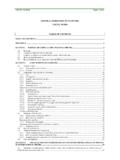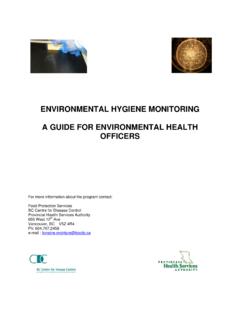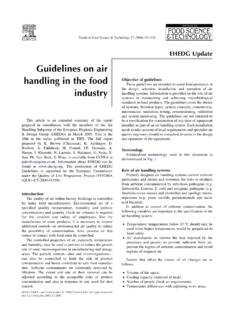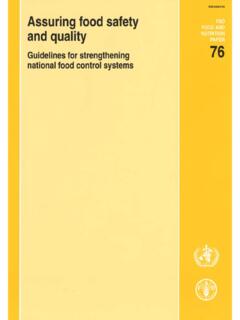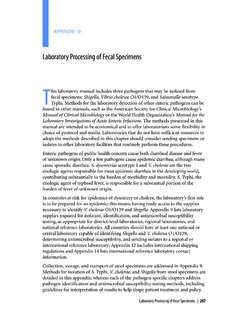Transcription of Standard Operating Procedure for PulseNet PFGE of
1 PNL05 Last Updated December 2017 Page 1 Standard Operating Procedure for PulseNet PFGE of Escherichia coli O157:H7, Escherichia coli non-O157 (STEC), salmonella serotypes, Shigella sonnei and Shigella flexneri Purpose To describe the One-Day (24-26 hour) Standardized Laboratory Protocol for Molecular Subtyping of E. coli O157:H7, E. coli Non-O157 (STEC), salmonella , Shigella sonnei and Shigella flexneri by Pulsed-field Gel Electrophoresis (PFGE). Scope To provide the PulseNet participants with a standardized Procedure for performing PFGE of E. coli O157:H7, E. coli Non-O157 (STEC), salmonella , Shigella sonnei and Shigella flexneri, thus ensuring inter-laboratory comparability of the generated results. Definitions and Terms : Pulsed-field Gel : Deoxyribonucleic : Centers for Disease Control and : Clinical Laboratory Reagent : T ris-E : Ethylenediaminetetraacetic : T ris borate-E : Heart Infusion AgarBiosafety Warning Escherichia coli O157:H7, salmonella serotypes, Shigella sonnei, and Shigella flexneri are human pathogens and can cause serious disease.
2 It has been reported that less than 100 cells of E. coli O157:H7 may cause infection. Shigella species also have a low infectious dose and are demonstrated hazards to laboratory personnel. Always use Biosafety Level 2 practices (at a minimum) and extreme caution when transferring and handling strains of these genera. Work in a biological safety cabinet when handling large amounts of cells. Disinfect or dispose of all plasticware and glassware that come in contact with the cultures in a safe manner. Please read all instructions carefully before starting protocol. It is recommended to plate cultures, prepare cell suspensions, and cast plugs in a Class II Biosafety Cabinet (BSC), if available. Treat all plasticware, glassware, pipets, spatulas, etc. that come in contact with the cell suspensions or plugs as contaminated materials and dispose of or disinfect according to your institutional guidelines.
3 PNL05 Last Updated December 2017 Page 2 Day 0 Plating for confluent growth an isolated colony from test cultures onto Trypticase Soy Agar (TSA) with 5% defibrinated sheep blood (TSA-SB) plates (or comparable non-selective media) for confluent growth. It is recommended that a storage vial of eachculture be created. To do this, stab small screw cap tubes of TSA, HIA, or similar medium with the same inoculatingloop used to streak the plate. This will ensure that the same colony can be retested if cultures at 37 C for 14-18 1 Preparing Cell Suspension on shaker water bath or incubator (54-55 C), stationary water baths (55-60 C) and, if applicable, thespectrophotometer used for measuring optical densities of cell suspensions during plug TE Buffer (10 mM Tris:1 mM EDTA, pH ) as 10 ml of 1 M Tris, pH 2 ml of M EDTA, pH Dilute to 1000 ml with sterile Ultrapure Clinical Laboratory Reagent Water (CLRW) Alternatively, TE Buffer may be purchased from a commercial vendor.
4 The TE Buffer is used to make the plug agarose and wash lysed PFGE plugs. 1% SeaKem Gold agarose in TE Buffer (10 mM Tris:1 mM EDTA, pH ) for PFGE plugs as Weigh g (or g) SeaKem Gold (SKG) agarose into 250 ml screw-cap Add ml (or ml) TE Buffer; swirl gently to disperse Loosen or cover loosely with clear film, and microwave for 30 seconds; mix gently and repeat for 10 secondsintervals until agarose is completely dissolved. Recap flask and return to 55-60 C water bath and equilibrate the agarose in the water bath for 15 minutes or untilready to use. SAFETY WARNING: USE HEAT-RESISTANT GLOVES WHEN HANDLING HOT FLASKS AFTER MICROWAVING. The time and temperature needed to completely dissolve the SeaKem Gold agarose is dependent on the specifications of the microwave used and will have to be determined empirically in each laboratory.
5 Small transparent tubes (12mm x 75mm Falcon 2054 tubes or equivalent) with culture 2 ml of Cell Suspension Buffer (CSB; 100 mM Tris:100 mM EDTA, pH as described in Formulas of PFGER eagents Section ) to small labeled tubes. The minimum volume of the cell suspension needed will depend on size ofthe cuvettes or tubes used to measure the cell concentration and are dependent on the manufacturer s specificationsfor the spectrophotometer, turbidity meter, or a sterile polyester-fiber or cotton swab that has been moistened with sterile CSB to remove some of the growthfrom agar plate; suspend cells in CSB by spinning swab gently so cells will be evenly dispersed and formation ofaerosols is minimized. Place suspensions on ice if you have more than 6 cultures to process or refrigerate cellsuspensions if you cannot adjust their concentration Last Updated December 2017 Page 3 concentration of cell suspensions to one of the values given below by diluting with sterile CSB or by addingadditional cells using a swab to remove more growth from the agar Spectrophotometer: 610 nm wavelength, Optical Density of (range of ) Microscan Turbidity Meter (Beckman Coulter): (measured in Falcon 2054 tubes) (measured in Falcon 2057 tubes) bioM rieux Vitek colorimeter: 17-18% transmittance (measured in Falcon 2054 tubes) The values in steps give satisfactory results at CDC; each laboratory may need to establish the optimal concentration needed for satisfactory results.
6 Casting Plugs The preparation of cell suspensions and subsequent casting of plugs should be performed as rapidly as possible in order to minimize premature cell lysis and solidification of agarose in the pipette tips/microcentrifuge tubes. If large numbers of samples are being prepared, it is recommended to process them in batches of ~10 samples at a time. Once the first batch of isolates are in the cell lysis incubation step, then the cell suspensions can be prepared for the next group of samples and so on. All batches can be lysed and washed together since additional lysis time will not affect the initial batches. Unused plug agarose can be kept at room temperature and reused 1 or 2 times. Microwave on low-medium power for 10-15 sec and mix; repeat for 5-10 sec intervals until agarose is completely melted.
7 Wells of PFGE plug molds with culture number. When reusable plug molds are used, put strip of tape on lowerpart of reusable plug mold before labeling 400 l adjusted cell suspensions to labeled microcentrifuge 20 l of Proteinase K (20 mg/ml stock) to each tube and mix gently with pipet K solutions (20 mg/ml) are available commercially. Alternatively, a stock solution of Proteinase K can be prepared from powder in sterile Ultrapure water (CLRW; see PNL02). Just before use, thaw appropriate number of vials needed for the samples; keep Proteinase K solutions on ice. If the Proteinase K stock solution was prepared from powder, discard any thawed solution at the end of the work day. Store commercially prepared Proteinase K solutions according to directions provided by the supplier. 400 l melted 1% SeaKem Gold agarose to 400 l cell suspension; mix by gently pipetting up and down two orthree times.
8 Over-pipeting can cause DNA shearing. Maintain temperature of melted agarose by keeping flask inbeaker of warm water (55-60 C). , dispense part of mixture into appropriate well(s) of reusable plug mold without introducing bubbles. Twoplugs of each sample (if reusable plug molds are used) can be made from these amounts of cell suspension and agaroseand are useful if repeat testing is required. Allow plugs to solidify at room temperature for 10-15 min. They can alsobe placed in the refrigerator (4 C) for 5 disposable plug molds are used, combine 200 l cell suspension, 10 l of Proteinase K (20 mg/ml stock) and 200 l of agarose; up to 4 plugs can be made from the smaller volumes. Lysis of Cells in Agarose Plugs Two plugs (reusable molds) or 3 4 plugs (disposable molds) of the same strain can be lysed in the same 50ml tube.
9 50ml polypropylene screw-cap tubes with culture Last Updated December 2017 Page 4 the total volume of Cell Lysis Buffer/Proteinase K master mix needed as 5 ml stock Cell Lysis Buffer (CLB; 50 mM Tris:50 mM EDTA, pH + 1% Sarcosyl per tube as prepared in Formulas of PFGE Reagents section). e. g., 5 ml x 10 tubes = 50 ml 25 l Proteinase K stock solution (20 mg/ml) is needed per tube of the cell lysis buffer e. g., 25 l x 10 tubes = 250 l Prepare the master mix by measuring the correct volume of Cell Lysis Buffer and Proteinase K into appropriate size conical tube or flask and mix well. 5 ml of Cell Lysis Buffer/Proteinase K master mix to each labeled 50 ml excess agarose from top of plugs with scalpel, razor blade or similar instrument (optional). Open reusable plugmold and transfer plugs from mold with a spatula to appropriately labeled tube.
10 If disposable plug molds are used,remove white tape from bottom of mold and push out plug(s) into appropriately labeled tube. Be sure plugs are underbuffer and not on side of excess agarose, scalpel, spatula, tape, etc. are contaminated. Dispose of or disinfect them appropriately. tape from reusable mold. Place both sections of plug mold, spatulas, and scalpel in 90% ethanol, 70%isopropanol, 1% Lysol or other suitable disinfectant. Soak them for at least 30 minutes before washing them. Discarddisposable plug molds tubes in non-Styrofoam rack and incubate in a 54-55 C shaker water bath or incubator for hr withconstant and vigorous agitation (175-200 rpm). Plugs can be lysed for longer periods of time (up to overnight). lysing in water bath, be sure water level in water bath is above level of lysis buffer in enough sterile CLRW and TE Buffer to 54-55 C so that plugs can be washed two times with 10-15 ml water(200-250 ml for 10 tubes) and washed four times with 10-15 ml TE (400-600 ml for 10 tubes).










